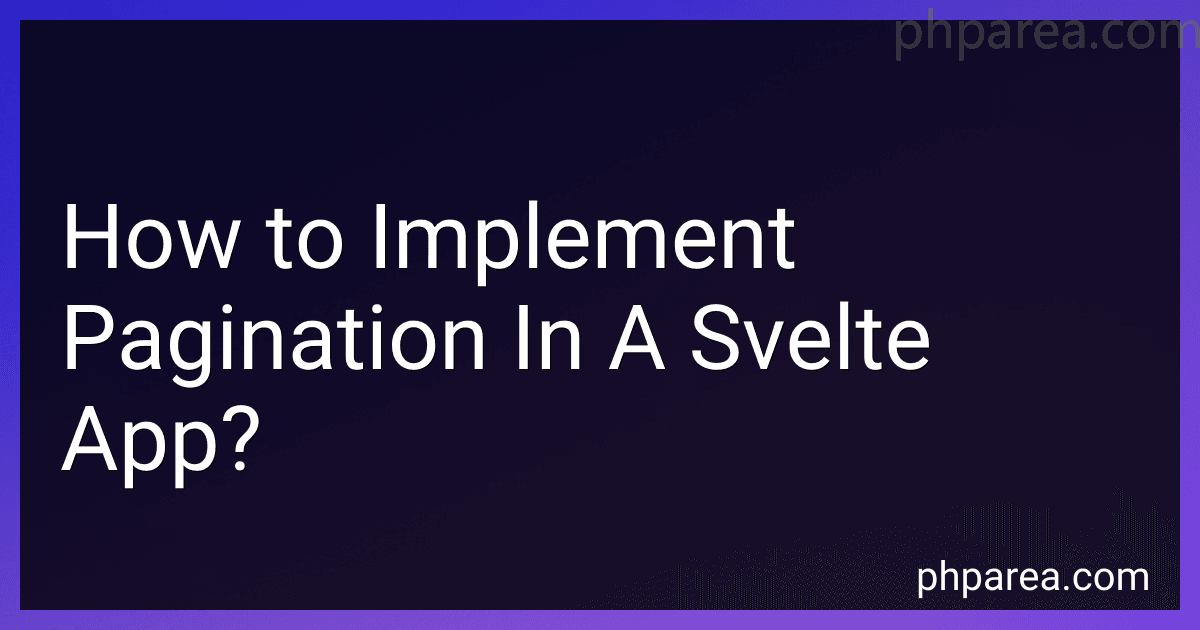PHP Blog
-
 8 min readIn Svelte, you can easily add animations to elements by using the built-in animate directive. This directive allows you to apply CSS animations to elements when certain conditions are met, such as when an element enters or leaves the DOM, or when a variable changes.To use the animate directive, simply add it to an element as an attribute and specify the CSS animation properties you want to apply. You can also use transition properties to control the timing and easing of the animation.
8 min readIn Svelte, you can easily add animations to elements by using the built-in animate directive. This directive allows you to apply CSS animations to elements when certain conditions are met, such as when an element enters or leaves the DOM, or when a variable changes.To use the animate directive, simply add it to an element as an attribute and specify the CSS animation properties you want to apply. You can also use transition properties to control the timing and easing of the animation.
-
 8 min readSvelte can be integrated with a CMS like WordPress or Contentful by using APIs provided by these CMS platforms. This allows developers to fetch content from the CMS and display it within Svelte components.For WordPress, developers can use the WordPress REST API to retrieve posts, pages, and other content from the CMS. These API endpoints can be called within Svelte components to display dynamic content.
8 min readSvelte can be integrated with a CMS like WordPress or Contentful by using APIs provided by these CMS platforms. This allows developers to fetch content from the CMS and display it within Svelte components.For WordPress, developers can use the WordPress REST API to retrieve posts, pages, and other content from the CMS. These API endpoints can be called within Svelte components to display dynamic content.
-
 5 min readTo implement infinite scrolling in a Svelte app, the first step is to set up a container element that will hold the scrollable content. Then, you will need to add an event listener to the container that listens for the scroll event.Next, you will need to calculate when the user has reached the end of the container by checking the scroll position and the height of the container. When the user is close to reaching the bottom, you can fetch more data to display in the scrollable content.
5 min readTo implement infinite scrolling in a Svelte app, the first step is to set up a container element that will hold the scrollable content. Then, you will need to add an event listener to the container that listens for the scroll event.Next, you will need to calculate when the user has reached the end of the container by checking the scroll position and the height of the container. When the user is close to reaching the bottom, you can fetch more data to display in the scrollable content.
-
 6 min readPagination in a Svelte app can be implemented by incorporating logic that determines how many items to display per page and which items to display based on the current page number. This can be achieved by utilizing Svelte's reactive variables to keep track of the current page number and the total number of items.First, you will need to create a component that contains the list of items that you want to paginate.
6 min readPagination in a Svelte app can be implemented by incorporating logic that determines how many items to display per page and which items to display based on the current page number. This can be achieved by utilizing Svelte's reactive variables to keep track of the current page number and the total number of items.First, you will need to create a component that contains the list of items that you want to paginate.
-
 5 min readLazy loading components in Svelte can improve the performance of your application by only loading components when they are actually needed. To achieve lazy loading in Svelte, you can use dynamic imports. By using the import() function, you can import components asynchronously when they are required.To lazy load a component in Svelte, you can import the component dynamically and then use Svelte's await block to load the component asynchronously.
5 min readLazy loading components in Svelte can improve the performance of your application by only loading components when they are actually needed. To achieve lazy loading in Svelte, you can use dynamic imports. By using the import() function, you can import components asynchronously when they are required.To lazy load a component in Svelte, you can import the component dynamically and then use Svelte's await block to load the component asynchronously.
-
 4 min readTo use Svelte with Webpack, you will first need to install the necessary dependencies. This includes svelte-loader, which allows Webpack to process Svelte components. Next, you will need to configure your Webpack configuration file to include the svelte-loader and specify the appropriate settings for handling Svelte components.You will also need to make sure that Webpack is able to handle the ".
4 min readTo use Svelte with Webpack, you will first need to install the necessary dependencies. This includes svelte-loader, which allows Webpack to process Svelte components. Next, you will need to configure your Webpack configuration file to include the svelte-loader and specify the appropriate settings for handling Svelte components.You will also need to make sure that Webpack is able to handle the ".
-
 5 min readIn Svelte, errors and exceptions can be handled by using the try/catch block in JavaScript. By wrapping code that may potentially throw an error inside a try block, you can catch and handle any exceptions that occur.Additionally, Svelte provides a special on:error event that can be added to elements to handle errors specific to that part of the component. This event can be used to display an error message or take any necessary actions when an error occurs.
5 min readIn Svelte, errors and exceptions can be handled by using the try/catch block in JavaScript. By wrapping code that may potentially throw an error inside a try block, you can catch and handle any exceptions that occur.Additionally, Svelte provides a special on:error event that can be added to elements to handle errors specific to that part of the component. This event can be used to display an error message or take any necessary actions when an error occurs.
-
 4 min readIn large Svelte apps, handling state management can become complex as the application grows in size and complexity. One common approach is to use a centralized state management solution such as Svelte's built-in context API or external libraries like Redux or MobX.Using a centralized state management solution allows you to manage the state of your application in a single location, making it easier to keep track of changes and maintain a consistent state throughout the app.
4 min readIn large Svelte apps, handling state management can become complex as the application grows in size and complexity. One common approach is to use a centralized state management solution such as Svelte's built-in context API or external libraries like Redux or MobX.Using a centralized state management solution allows you to manage the state of your application in a single location, making it easier to keep track of changes and maintain a consistent state throughout the app.
-
 5 min readTo create a custom search page in Drupal, you can start by creating a new template file for your search page. You can name this file something like search--custom.tpl.php. In this template file, you can define the layout and design of your custom search page using HTML and PHP.Next, you can create a new module or modify an existing module to define the search functionality for your custom search page.
5 min readTo create a custom search page in Drupal, you can start by creating a new template file for your search page. You can name this file something like search--custom.tpl.php. In this template file, you can define the layout and design of your custom search page using HTML and PHP.Next, you can create a new module or modify an existing module to define the search functionality for your custom search page.
-
 9 min readCreating reusable Svelte libraries involves structuring your code in a way that makes it easy to share and reuse across different projects. One approach is to create a Svelte package using a bundler like Rollup or Webpack. This allows you to bundle your components and export them as a standalone library that can be easily imported into other Svelte projects.When creating your library, it's important to follow best practices for organizing your code.
9 min readCreating reusable Svelte libraries involves structuring your code in a way that makes it easy to share and reuse across different projects. One approach is to create a Svelte package using a bundler like Rollup or Webpack. This allows you to bundle your components and export them as a standalone library that can be easily imported into other Svelte projects.When creating your library, it's important to follow best practices for organizing your code.
-
 7 min readTo create a sitemap in Drupal, you can use the XML sitemap module. First, you need to download and enable this module on your Drupal site. Once the module is enabled, go to Configuration > Search and Metadata > XML Sitemap to configure the sitemap settings. Here, you can specify the content types, taxonomy terms, and other links that should be included in the sitemap.
7 min readTo create a sitemap in Drupal, you can use the XML sitemap module. First, you need to download and enable this module on your Drupal site. Once the module is enabled, go to Configuration > Search and Metadata > XML Sitemap to configure the sitemap settings. Here, you can specify the content types, taxonomy terms, and other links that should be included in the sitemap.